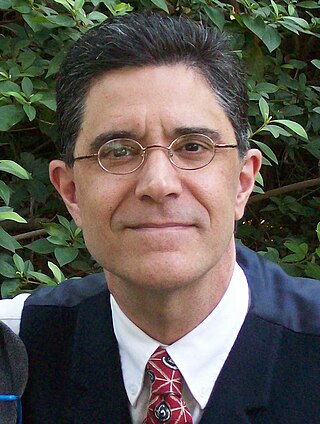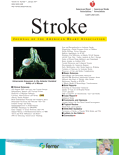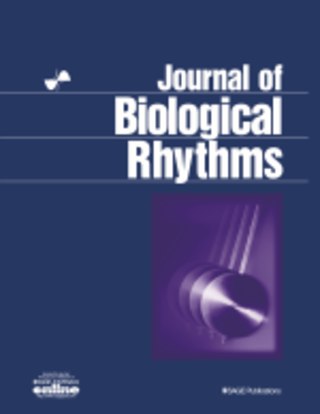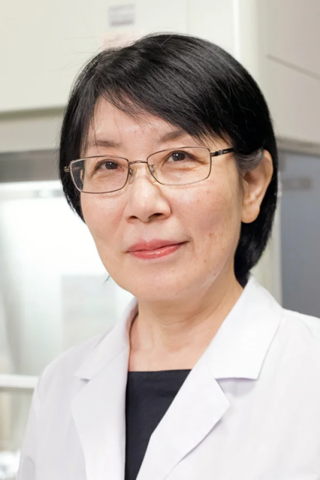
A circadian rhythm, or circadian cycle, is a natural oscillation that repeats roughly every 24 hours. Circadian rhythms can refer to any process that originates within an organism and responds to the environment. Circadian rhythms are regulated by a circadian clock whose primary function is to rhythmically co-ordinate biological processes so they occur at the correct time to maximise the fitness of an individual. Circadian rhythms have been widely observed in animals, plants, fungi and cyanobacteria and there is evidence that they evolved independently in each of these kingdoms of life.

Chronobiology is a field of biology that examines timing processes, including periodic (cyclic) phenomena in living organisms, such as their adaptation to solar- and lunar-related rhythms. These cycles are known as biological rhythms. Chronobiology comes from the ancient Greek χρόνος, and biology, which pertains to the study, or science, of life. The related terms chronomics and chronome have been used in some cases to describe either the molecular mechanisms involved in chronobiological phenomena or the more quantitative aspects of chronobiology, particularly where comparison of cycles between organisms is required.

Delayed sleep phase disorder (DSPD), more often known as delayed sleep phase syndrome and also as delayed sleep–wake phase disorder, is the delaying of a person's circadian rhythm compared to those of societal norms. The disorder affects the timing of biological rhythms including sleep, peak period of alertness, core body temperature, and hormonal cycles.

BJU International is a monthly peer-reviewed medical journal that was established in 1929. The editor-in-chief is Freddie Hamdy and the journal is published by Wiley-Blackwell. It covers research on all aspects of urology.
Non-24-hour sleep–wake disorder is one of several chronic circadian rhythm sleep disorders (CRSDs). It is defined as a "chronic steady pattern comprising [...] daily delays in sleep onset and wake times in an individual living in a society". Symptoms result when the non-entrained (free-running) endogenous circadian rhythm drifts out of alignment with the light–dark cycle in nature. Although this sleep disorder is more common in blind people, affecting up to 70% of the totally blind, it can also affect sighted people. Non-24 may also be comorbid with bipolar disorder, depression, and traumatic brain injury. The American Academy of Sleep Medicine (AASM) has provided CRSD guidelines since 2007 with the latest update released in 2015.
A chronotype is the behavioral manifestation of underlying circadian rhythm's myriad of physical processes. A person's chronotype is the propensity for the individual to sleep at a particular time during a 24-hour period. Eveningness and morningness are the two extremes with most individuals having some flexibility in the timing of their sleep period. However, across development there are changes in the propensity of the sleep period with pre-pubescent children preferring an advanced sleep period, adolescents preferring a delayed sleep period and many elderly preferring an advanced sleep period.
Schizophrenia Research is a peer-reviewed medical journal covering research on the cause, clinical diagnostics, and treatment of schizophrenia. It is an official journal of the Schizophrenia International Research Society and was established in 1988. The editor-in-chief is Matcheri Keshavan and the former editors are Henry Nasrallah and Lynn DeLisi. According to Schizophrenia Research's original mission statement, the journal is aimed at
bringing together previously separated biological, clinical and psychological research on this disorder, and stimulate the synthesis of these data into cohesive hypotheses.

Biological Psychiatry is a biweekly, peer-reviewed, scientific journal of psychiatric neuroscience and therapeutics, published by Elsevier since 1985 on behalf of the Society of Biological Psychiatry, of which it is the official journal. The journal covers a broad range of topics related to the pathophysiology and treatment of major neuropsychiatric disorders. A yearly supplement is published which contains the abstracts from the annual meeting of the Society of Biological Psychiatry.
Mary A. Carskadon is one of the most prominent American researchers in sleep. She is a Professor in the Department of Psychiatry and Human Behavior at the Warren Alpert Medical School of Brown University. She is also the Director of the Sleep and Chronobiology Research Lab at E.P. Bradley Hospital. She is considered to be an expert on sleep and circadian rhythms during childhood, adolescence and young adulthood. She researches issues related to daytime sleepiness. She has also contributed important research on school start times as it relates to sleep patterns and sleepiness in adolescence. Every summer, Dr. Carskadon offers a prestigious summer internship for highly motivated students interested in sleep research at the Bradley Sleep Lab. These students, known as Dement Fellows, after William C. Dement, work in the sleep lab for the entirety of the summer and learn under Dr. Carskadon.

Roberto Refinetti is a behavioral physiologist and higher-education administrator. He is best known for his book Circadian Physiology and is ranked in the top 2% of scientists in the world.

Stroke is a peer-reviewed medical journal published monthly by Lippincott Williams & Wilkins on behalf of the American Heart Association. It covers research on cerebral circulation and related diseases, including clinical research on assessment of risk for stroke, diagnosis, prevention, and treatment, as well as rehabilitation. All articles become open access after a 12-month embargo. The editor-in-chief was Ralph L. Sacco.

The Journal of Biological Rhythms is a bimonthly peer-reviewed scientific journal that covers chronobiology or any rhythms, especially biological rhythms with a special emphasis on seasonal and circadian rhythms. The journal publishes primary reports, reviews, commentaries, or letters. The Journal of Biological Rhythms has been in publication since 1986 and is currently published by SAGE Publications. The journal is the official publication of the Society for Research on Biological Rhythms. The editor-in-chief is William J. Schwartz.
Till Roenneberg is a professor of chronobiology at the Institute of Medical Psychology at Ludwig-Maximilian University (LMU) in Munich, Germany. Roenneberg, in collaboration with Martha Merrow, explores the impact of light on human circadian rhythms, focusing on aspects such as chronotypes and social jet lag in relation to health benefits.
Derk-Jan Dijk is a researcher of sleep and circadian rhythms. As of 2005 he is a Distinguished Professor at the University of Surrey and the director of its Sleep Research Centre.

Carl Hirschie Johnson is an American-born biologist who researches the chronobiology of different organisms, most notably the bacterial circadian rhythms of cyanobacteria. Johnson completed his undergraduate degree in Honors Liberal Arts at the University of Texas at Austin, and later earned his PhD in biology from Stanford University, where he began his research under the mentorship of Dr. Colin Pittendrigh. Currently, Johnson is the Stevenson Professor of Biological Sciences at Vanderbilt University.
The Society for Research on Biological Rhythms (SRBR) is an international chronobiological research society with three key goals:
- to promote the advancement and dissemination of basic and applied research in all aspects of biological rhythms.
- to enhance the education and training of students and researchers in the field.
- to foster interdisciplinary communication and an international exchange of ideas.
Martha Merrow is an American chronobiologist. She currently chairs the Institute of Medical Psychology at the Ludwig Maximilian University of Munich. Her career focuses primarily on investigating the molecular and genetic mechanisms of the circadian clock. Since joining the Ludwig Maximilian University in 1996, Merrow has investigated molecular and genetic mechanisms of the circadian clock as well as daily human behavior and medical psychology.

Sato Honma is a Japanese chronobiologist who researches the biological mechanisms of circadian rhythms. She mainly collaborates with Ken-Ichi Honma on publications, and both of their primary research focuses are the human circadian clock under temporal isolation and the mammalian suprachiasmatic nucleus (SCN), its components, and associates. Honma is a retired professor at the Hokkaido University School of Medicine in Sapporo, Japan. She received her Ph.D. in physiology from Hokkaido University. She taught physiology at the School of Medicine and then at the Research and Education Center for Brain Science at Hokkaido University. She is currently the director at the Center for Sleep and Circadian Rhythm Disorders at Sapporo Hanazono Hospital and works as a somnologist.
Ken-Ichi Honma is a Japanese chronobiologist who researches the biological mechanisms underlying circadian rhythms. After graduating from Hokkaido University School of Medicine, he practiced clinical psychiatry before beginning his research. His recent research efforts are centered around photic and non-photic entrainment, the structure of circadian clocks, and the ontogeny of circadian clocks. He often collaborates with his wife, Sato Honma, in work involving the mammalian suprachiasmatic nucleus (SCN), its components, and associated topics.

Lynne Lamberg is an American freelance medical journalist, writer and editor. In addition to books on sleep, dreams, and biological rhythms, she has written hundreds of articles on mental and physical health for medical professionals and the general public.











